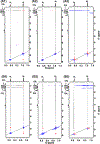Structure Dependence of Pyridine and Benzene Derivatives on Interactions with Model Membranes
- PMID: 29958493
- PMCID: PMC6106790
- DOI: 10.1021/acs.langmuir.8b01661
Structure Dependence of Pyridine and Benzene Derivatives on Interactions with Model Membranes
Abstract
Pyridine-based small-molecule drugs, vitamins, and cofactors are vital for many cellular processes, but little is known about their interactions with membrane interfaces. These specific membrane interactions of these small molecules or ions can assist in diffusion across membranes or reach a membrane-bound target. This study explores how minor differences in small molecules (isoniazid, benzhydrazide, isonicotinamide, nicotinamide, picolinamide, and benzamide) can affect their interactions with model membranes. Langmuir monolayer studies of dipalmitoylphosphatidylcholine (DPPC) or dipalmitoylphosphatidylethanolamine (DPPE), in the presence of the molecules listed, show that isoniazid and isonicotinamide affect the DPPE monolayer at lower concentrations than the DPPC monolayer, demonstrating a preference for one phospholipid over the other. The Langmuir monolayer studies also suggest that nitrogen content and stereochemistry of the small molecule can affect the phospholipid monolayers differently. To determine the molecular interactions of the simple N-containing aromatic pyridines with a membrane-like interface, 1H one-dimensional NMR and 1H-1H two-dimensional NMR techniques were utilized to obtain information about the position and orientation of the molecules of interest within aerosol-OT (AOT) reverse micelles. These studies show that all six of the molecules reside near the AOT sulfonate headgroups and ester linkages in similar positions, but nicotinamide and picolinamide tilt at the water-AOT interface to varying degrees. Combined, these studies demonstrate that small structural changes of small N-containing molecules can affect their specific interactions with membrane-like interfaces and specificity toward different membrane components.
Conflict of interest statement
The authors declare no competing financial interest.
Figures







Similar articles
-
Correlation of insulin-enhancing properties of vanadium-dipicolinate complexes in model membrane systems: phospholipid langmuir monolayers and AOT reverse micelles.Chemistry. 2014 Apr 22;20(17):5149-59. doi: 10.1002/chem.201201803. Epub 2014 Mar 11. Chemistry. 2014. PMID: 24615733
-
Molecular dynamics simulation study of the effect of halothane on mixed DPPC/DPPE phospholipid membranes.J Mol Model. 2018 Dec 15;25(1):4. doi: 10.1007/s00894-018-3890-6. J Mol Model. 2018. PMID: 30554281
-
Gel formulation containing mixed surfactant and lipids associating with carboplatin.Chem Biodivers. 2011 Dec;8(12):2195-210. doi: 10.1002/cbdv.201100097. Chem Biodivers. 2011. PMID: 22162158
-
Role of dipolar interaction in the mesoscopic domains of phospholipid monolayers: dipalmitoylphosphatidylcholine and dipalmitoylphosphatidylethanolamine.Langmuir. 2007 Jun 19;23(13):6991-6. doi: 10.1021/la070168z. Epub 2007 May 26. Langmuir. 2007. PMID: 17530786
-
Geometry and nanolength scales versus interface interactions: water dynamics in AOT lamellar structures and reverse micelles.J Am Chem Soc. 2009 Jun 17;131(23):8318-28. doi: 10.1021/ja901950b. J Am Chem Soc. 2009. PMID: 19449867
Cited by
-
The Interactions of Anti-HIV Pronucleotides with a Model Phospholipid Membrane.Molecules. 2024 Dec 7;29(23):5787. doi: 10.3390/molecules29235787. Molecules. 2024. PMID: 39683946 Free PMC article.
-
The Interfacial Interactions of Glycine and Short Glycine Peptides in Model Membrane Systems.Int J Mol Sci. 2020 Dec 26;22(1):162. doi: 10.3390/ijms22010162. Int J Mol Sci. 2020. PMID: 33375246 Free PMC article.
-
Arginine Gemini-Based Surfactants for Antimicrobial and Antibiofilm Applications: Molecular Interactions, Skin-Related Anti-Enzymatic Activity and Cytotoxicity.Molecules. 2023 Sep 11;28(18):6570. doi: 10.3390/molecules28186570. Molecules. 2023. PMID: 37764346 Free PMC article.
References
-
- Azuma K; Ouchi Y; Inoue S Vitamin K: Novel Molecular Mechanisms of Action and Its Roles in Osteoporosis. Geriatr Gerontol Int. 2014, 14 (1), 1–7. - PubMed
-
- Lambert RJ; Stratford M Weak-Acid Preservatives: Modelling Microbial Inhibition and Response. J. Appl. Microbiol 1999, 86 (1), 157–164. - PubMed
-
- Zhang Y; Wade MM; Scorpio A; Zhang H; Sun ZH Mode of Action of Pyrazinamide: Disruption of Mycobacterium Tuberculosis Membrane Transport and Energetics by Pyrazinoic Acid. J. Antimicrob. Chemother 2003, 52 (5), 790–795. - PubMed
Publication types
MeSH terms
Substances
Grants and funding
LinkOut - more resources
Full Text Sources
Other Literature Sources

